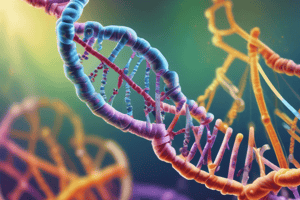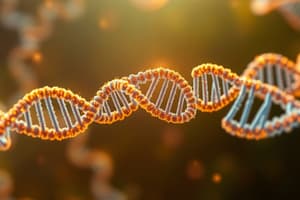Podcast
Questions and Answers
What is the purpose of forming the pre-initiation complex (PIC)?
What is the purpose of forming the pre-initiation complex (PIC)?
- To mark the TSS site (correct)
- To transcribe a gene
- To replicate DNA
- To synthesize proteins
What is recognized by the TBP in the promoter region?
What is recognized by the TBP in the promoter region?
- The TSS site
- The CAAT box
- The TATA box (correct)
- The coding region
In what percentage of genes does the TBP act as a true TBP?
In what percentage of genes does the TBP act as a true TBP?
- 100%
- 80%
- 20% (correct)
- 50%
What is the order of recruitment of factors to form the PIC?
What is the order of recruitment of factors to form the PIC?
What is the function of the TAFs in the promoter region?
What is the function of the TAFs in the promoter region?
What happens to the PIC in promoters with multiple TSS sites?
What happens to the PIC in promoters with multiple TSS sites?
What is the name of the complex formed after the incorporation of the necessary factors?
What is the name of the complex formed after the incorporation of the necessary factors?
What is the role of the helicase activity in the PIC?
What is the role of the helicase activity in the PIC?
What happens to the transcription factors after the RNA polymerase has moved?
What happens to the transcription factors after the RNA polymerase has moved?
What is the role of TFIIS in the transcription process?
What is the role of TFIIS in the transcription process?
What is the purpose of the reiniciation of RNA Pol II?
What is the purpose of the reiniciation of RNA Pol II?
How does the RNA Pol II locate the promoter region?
How does the RNA Pol II locate the promoter region?
What is the role of the CTD in the RNA Pol II?
What is the role of the CTD in the RNA Pol II?
What is the structural difference between the PIC and the open complex?
What is the structural difference between the PIC and the open complex?
What is the function of the TFIIH subunit Ssl2?
What is the function of the TFIIH subunit Ssl2?
How does the RNA Pol II interact with the DNA?
How does the RNA Pol II interact with the DNA?
What is the primary function of Ssl2 in the process of transcription?
What is the primary function of Ssl2 in the process of transcription?
What is the difference between the closed complex and the open complex in transcription?
What is the difference between the closed complex and the open complex in transcription?
What is the role of the TFIIH complex in transcription?
What is the role of the TFIIH complex in transcription?
What is the purpose of the promoter proximal in gene transcription?
What is the purpose of the promoter proximal in gene transcription?
What is the difference between the initial transcribing complex and the elongation complex?
What is the difference between the initial transcribing complex and the elongation complex?
What is the role of the mediator complex in transcription?
What is the role of the mediator complex in transcription?
What is the primary function of the promoter region in gene transcription?
What is the primary function of the promoter region in gene transcription?
What is the difference between the pre-initiation complex and the open complex?
What is the difference between the pre-initiation complex and the open complex?
What is the role of the TFIIA complex in transcription?
What is the role of the TFIIA complex in transcription?
What is the purpose of the promoter distal region in gene transcription?
What is the purpose of the promoter distal region in gene transcription?
What is the primary function of the mediator complex in gene transcription?
What is the primary function of the mediator complex in gene transcription?
What is the characteristic of remodeler complexes that allows them to recognize specific types of nucleosomes?
What is the characteristic of remodeler complexes that allows them to recognize specific types of nucleosomes?
What is the effect of remodeler complexes on nucleosomes during transcription initiation?
What is the effect of remodeler complexes on nucleosomes during transcription initiation?
What is the role of the mediator complex in promoters without a TATA box?
What is the role of the mediator complex in promoters without a TATA box?
What is the function of the ATPase activity in remodeler complexes?
What is the function of the ATPase activity in remodeler complexes?
What is the effect of histone acetylation on remodeler complexes?
What is the effect of histone acetylation on remodeler complexes?
What is the role of the mediator complex in the formation of the PIC?
What is the role of the mediator complex in the formation of the PIC?
What is the characteristic of the mediator complex in terms of its size?
What is the characteristic of the mediator complex in terms of its size?
What is the effect of remodeler complexes on chromatin structure?
What is the effect of remodeler complexes on chromatin structure?
What is the role of the TBP in promoters with a TATA box?
What is the role of the TBP in promoters with a TATA box?
Flashcards are hidden until you start studying
Study Notes
Formation of the Pre-initiation Complex (PIC)
- The PIC is formed through a sequential model, where several factors bind to the promoter region of the DNA.
- The process begins with the recognition of the TATA box by TBP (TATA-binding protein) accompanied by the SAGA complex (in SP promoters) or TFIID (in non-TATA promoters).
- TFIID incorporates TBP and TAFs (TBP-associated factors) to bind to the promoter region.
- Not all promoters are recognized directly by TBP; some are recognized by other factors that form TFIIB.
- The PIC is formed through the recruitment of several factors, including TFIIA, TFIIB, TFIIE, TFIIH, and TFIIJ.
Structure of the PIC
- The PIC is a large complex that includes RNA polymerase II, TBP, TFIIA, TFIIB, and TFIIH.
- The DNA is positioned in the center, and the polymerase is located on one side, while the other factors are positioned on the other side.
- The PIC is held together by protein-protein interactions, allowing the polymerase to access the DNA.
- The complex is dynamic, with factors entering and leaving as transcription proceeds.
Initiation of Transcription
- The transition from the PIC to the open complex (OC) involves the unwinding of the DNA and the binding of the polymerase to the template strand.
- This process requires the activity of TFIIH, which has a helicase subunit that unwinds the DNA.
- The polymerase begins transcription by adding nucleotides to the growing RNA chain.
- As transcription proceeds, the polymerase moves along the DNA, and the factors that made up the PIC dissociate and reassociate with the promoter.
Elongation of Transcription
- The transition from the OC to the elongation complex (EC) occurs when the polymerase begins to synthesize RNA at a high rate.
- During elongation, the polymerase moves rapidly along the DNA, and the RNA grows in size.
- The polymerase may encounter obstacles, such as pauses or roadblocks, which can cause it to stall or backtrack.
Regulation of Transcription
- Transcriptional regulation occurs at multiple levels, including the recruitment of general transcription factors, the binding of specific transcription factors, and the modification of chromatin structure.
- Chromatin remodeling complexes, such as the SWI/SNF complex, play a crucial role in accessing the promoter region by reorganizing the nucleosomes.
- These complexes can either relax or compact chromatin, allowing or blocking access to the promoter region.
Chromatin Remodeling Complexes
- Chromatin remodeling complexes are multi-protein complexes that use ATP to reorganize the nucleosomes and facilitate transcription.
- These complexes often have helicase activity and can recognize specific histone modifications, such as acetylation.
- Examples of chromatin remodeling complexes include the SWI/SNF complex, the RSC complex, and the Mi-2/NuRD complex.
Studying That Suits You
Use AI to generate personalized quizzes and flashcards to suit your learning preferences.




